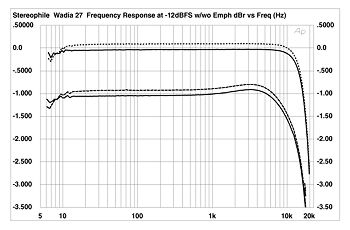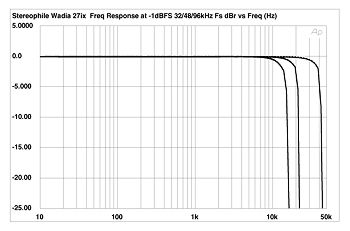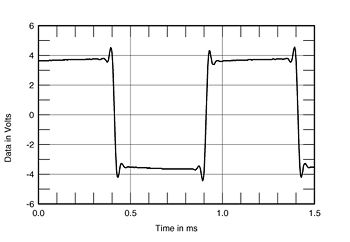| Columns Retired Columns & Blogs |
Wadia 27ix & Wadia 270 transport Measurements
Sidebar 3: Measurements
The Wadia 27ix's output is noninverting from both its unbalanced and balanced outputs (the latter with pin 2 hot). The source impedance was a very low 8.1 ohms across the audio band from the unbalanced outputs, approximately double that from the balanced jacks at 15 ohms. Both are low enough to drive long interconnects and awkward loads without problem, facilitating the Wadia's use without a preamp. The maximum output level as supplied for review was 4.34V from the unbalanced outputs, 4.28V balanced. Channel balance was a superb 0.01dB.
The time-domain-optimized filter used by Wadia results in a premature rolloff in the top octave of the audio band. This can be seen in the top traces in fig.1, where the output is flat to 10kHz but almost 3dB down at 20kHz. (This is the balanced output response; the unbalanced output was identical.) While this is audible, I didn't find it a serious problem in my auditioning (my hearing cuts off at 16kHz). More noticeable is the response with de-emphasis, the lower traces in fig.1. The processor's output peaks up a little, then starts to roll off above 6kHz. This will be audible with the very small number of pre-emphasized discs. The 27ix's channel separation (not shown) was superb, at better than 120dB below 4kHz (L-R), and approaching 130dB at 100Hz (R-L). (This difference might well be due to differing noise levels in the two channels.)

Fig.1 Wadia 27ix, frequency response at -12dBFS and 44.1kHz sampling, balanced outputs, without (top traces) and with (bottom traces) pre-/de-emphasis. (Right channel dashed and offset by 0.1dB for clarity, 0.5dB/vertical div.)
used a dCS 904 A/D converter to digitize the analog output of the Audio Precision System One at 32kHz, 48kHz, and 96kHz sample rates. The resulting response sweeps are shown in fig.2. The slower-than-usual rolloff above the desired passband can be seen in each case. But note that the rolloff is separately defined for each sample frequency. With the usual 96kHz-capable D/A converter—see fig.3 in my review of the Musical Fidelity X-24K (February '99, p.110)—the higher-frequency response is fundamentally the same at all sample rates; it is just curtailed earlier at the lower rates, which appears to mean that the same digital filter is used. With the Wadia, however, the high-frequency response is different in each case, suggesting that the filter is redefined for each sample rate.

Fig.2 Wadia 27ix, frequency response at -2dBFS and (from left to right) 32kHz, 48kHz, and 96kHz sampling. (Right channel dashed, 5dB/vertical div.)

Fig.3 Wadia 27ix, 1kHz squarewave at 0dBFS, 48kHz sampling.
- Log in or register to post comments



































